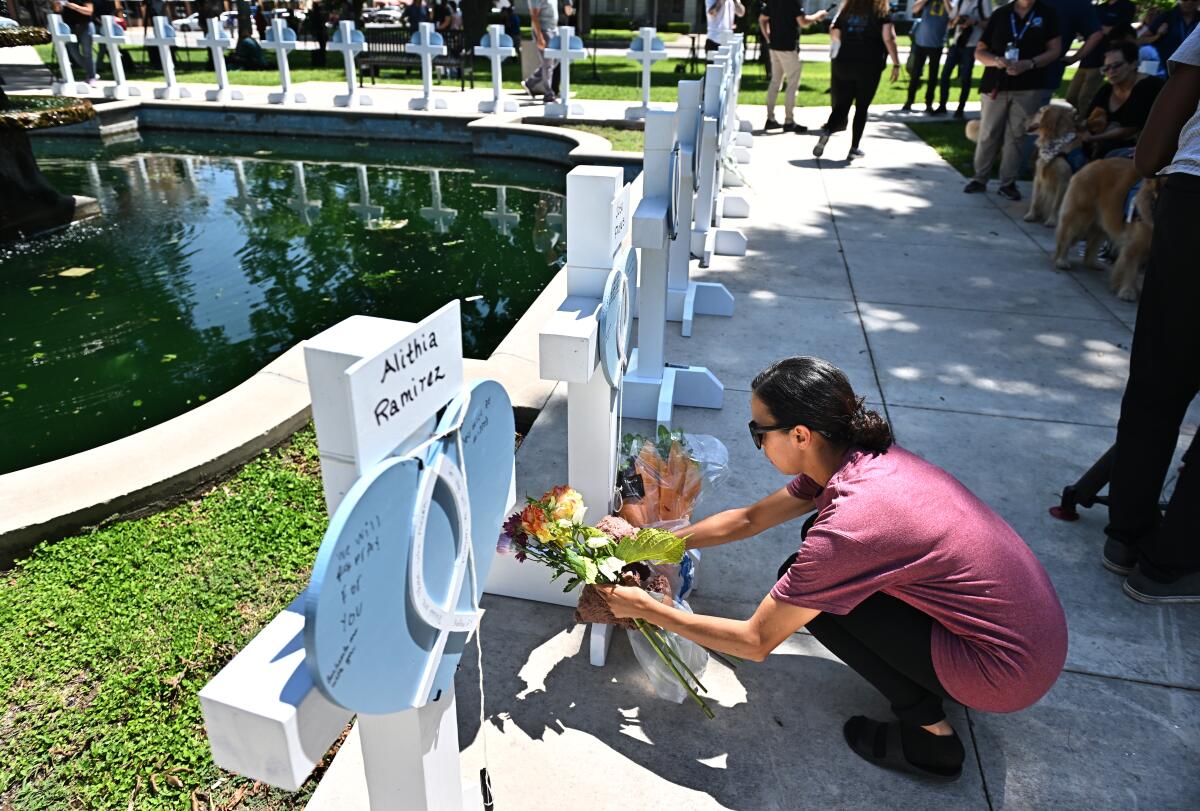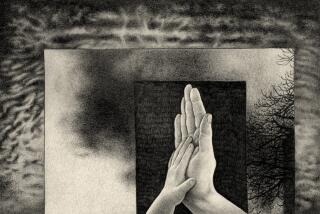You may feel secondary trauma from all the coverage of mass shootings. Therapists discuss ways to cope

- Share via
You can’t stop thinking about the violence. Social media apps that often distract us from reality are flooded with it.
Whether you’re feeling terrified, outraged, overwhelmed, despondent or numb, you may start to feel it in your body — each headline, quote, photo or video producing a physical sensation.
By consuming news of each mass shooting — from Buffalo to Laguna Woods to Uvalde — we are experiencing what experts call secondary and collective trauma.
And as our body is sending us signals, experts suggest that we start to pay attention.
“Symptoms are your body’s way of communicating that there’s an issue happening,” said Amanda Seon-Walker, clinical psychologist and president of the Southern California Chapter of the Assn. of Black Psychologists.
For the last several weeks, we’ve been left with little space to process one tragedy before absorbing another.
And because many of the victims have been Black, Latino and Asian, members of these racial, ethnic or cultural communities who witness the deaths, even from afar, can feel as if they’re happening as close as home.
We asked four psychologists about secondary and collective trauma, how it affects us and what we can do in response to healthily process and cope. Here are their responses.
The COVID-19 pandemic has affected nearly everyone’s mental health. If you’re looking for help, here’s a list of resources
Q. What should people understand about secondary trauma or collective trauma? Who can that affect?
Manuel Zamarripa, clinical psychologist and president-elect of the National Latinx Psychologists Assn., and Oscar Fernando Rojas Perez, clinical psychologist and policy advisor for NLPA: People should understand that collective trauma is a psychological reaction/response to a traumatic/terrible event; for example, the events in Uvalde and Buffalo, experienced and shared by a group of people. And [it] can affect an entire community, in this case the Latinx population and additional minoritized communities. It is also normal for people to feel powerless and experience strong emotions. Collective trauma differs from individual trauma in the sense that collective memory persists beyond the lives of the direct survivor of the events and is remembered by group members that may be far removed from the terrible event in time and space.
It is also important to note that survivors of the event will remember the tragedy differently than those who witnessed the actual event, and the constructions of the events may take different shape and form from individual to individual. Further, when a society or community has a shared membership that is significant to their identity, then this secondary trauma can be especially impactful.
Anjuli Amin, clinical psychologist and president of the Asian American Psychologists Assn.: We see this process of secondary trauma (vicarious traumatization) often in first responders, medical professionals and those who are routinely exposed to trauma. Research is showing us, however, that exposure to traumatic events through the media can lead observers to experience anxiety, difficulties in coping, feelings of helplessness and immense fear. In a sense it can affect us all, particularly with how difficult it can be to escape the constant news cycle.
Amanda Seon-Walker, clinical psychologist and president of the Southern California Chapter of the Assn. of Black Psychologists: Trauma in general has to do with when it overwhelms your ability to address something, your coping skills. With secondary trauma, a lot of people don’t recognize that the things assaulting them from the media are assaulting their own ability to cope. So sometimes people have to get aware of what’s going on for them and what’s going on in their own body, in response to what they’re consuming.
It certainly affects individuals who have more stressful life situations. I would say that’s who really needs to be aware — those who have a predisposition for stress, because that could be the thing that takes people beyond their coping mechanisms. The other people it could really impact [are] people who have a worldview that the world is safe. When [mass shootings happen] back to back to back, it can really shatter a person’s worldview in terms of, “What is my world like?” “Is my world really as safe as it is?” “Am I safe where I am?”
Q. When the victims of mass shootings come from your community, race or cultural background, how does this add another layer of trauma?
Seon-Walker: If it’s specific to someone that looks like me, then, “What does that mean about me? What are those people saying about people who look like me? Are we somehow not as great? Are we somehow expendable? Are our lives not worth as much if we’re targeted to be killed like that?”
There’s a general sense of, “I don’t matter, my life doesn’t matter.” And, “I’m expendable because of how I look? Things that I had no control over?” None of us chose who we were born to, and what our ethnicity was. We can’t choose that in advance. But we’re persecuted based on ethnic features that we can’t do anything about.
Amin: When there is a personal connection to an event such as a mass shooting, it can activate our fight-or-flight response so that we feel anxious, hyper-vigilant, fearful. We may begin to respond to our environment as though we are in survival mode. It can also bring up our own experiences of trauma, adding to the response we have in the moment, but also taking us back to our past where we may start to experience emotional distress in response to those memories.
It may also reinforce certain beliefs or views of the world that we have developed based on our life experiences. For example, if I hold a belief that the world is a dangerous place, witnessing something such as a mass shooting may reinforce that.
Zamarripa and Rojas Perez: When the victims of mass shooting are members of a racial and/or ethnic community, it is common for individuals of said community to experience a heightened sense of feeling unsafe in daily life — work, home and community. It can also serve as a reminder of past and other present acts of aggression, violence, violation that may have been experienced by others, and experiences of “isms.” People are also likely to experience poor mental health in the following months. It is also common for people of said community to experience discrimination and be vilified by the media. As a result, people of racial and ethnic communities become more vulnerable to experiences of racial and ethnic trauma.
Q. How did you react to the shootings in Buffalo, in Laguna Woods and in Uvalde, respectively, and what have you been doing to process those events and cope?
Seon-Walker: I grew up in New York. So it was particularly salient for me. I had many friends who went to SUNY Buffalo. I ended up speaking to someone that weekend who used to go and party in that very area where the shooting happened. And so it really struck home, to have that violence happen in New York, and to have that violence happening in Buffalo. And what it says to me is that there’s still a lot of work that needs to be done.
I wondered about how [the suspected gunman’s] exposure to people that look different from him might have changed his decision. Because I think that there’s a lot of pull right now in the country for people to separate and segregate even more. And I feel like that’s the wrong answer. If we separate and segregate more, then we become the other, become the unknown. And you can vilify that which you don’t know. If you have too many examples of wonderful people who don’t look like you, then you’re less likely to think that all these people can be this way because I have too many overwhelming samples. I think it humanizes more. And so I’ve kind of had that reaction.
You know, how might this have been different? If he had different interactions, if he felt more connected to other people on a human level? If there was more support given to him earlier in his life, how could that have changed this outcome?
Amin: I initially experienced a sense of shock, sadness and worry. As time went on and I read more about the details of these and the other shootings, as well as all the opinions and commentary, I began to feel a sense of numbness. It was hard to connect with any feeling at all for some time, and I found myself in a really negative state of mind.
Acknowledging that was a “check engine light” moment — a sign that I was carrying a lot of stress and needed to stop and process. What was most helpful was connecting with the present moment and my own community — having tea with my parents, talking about what I was feeling with my colleagues, and setting boundaries with work to ensure I was leaving work at the door when I came home. It has also been helpful to hear others process their emotion and to be in community, both face to face and virtually.
Zamarripa and Rojas Perez: These are devastating losses, and we reacted with deep sadness, shock, horror and anger. It is difficult to see members of our community hurting and in need of immediate healing. Avoidance of the news and social media was also common, as it triggered past memories of other events that have harmed our community.
Zamarripa: To cope: Stayed connected with supportive loved ones, took time individually to grieve, not flooding [ourselves] with images and news coverage.
Rojas Perez: In addition, after validating personal thoughts and emotions, transformed the anger and sadness into resilience and solutions to help our local community start the healing process. I have also joined community healing circles and sought support from mental health professionals. Most importantly, validated my emotions and thoughts.
Q. What kinds of challenges and experiences have you been hearing from your patients since these shootings?
Zamarripa and Rojas Perez: Patients have voiced how scared they are to send their children to school. They have shared wanting to purchase bulletproof backpacks or bulletproof vests for their children. Patients have also shared feeling targeted, especially our patients with undocumented status who also struggle with the constant fear of being deported. In addition, patients have noted avoiding news coverage of the event, as it prompts sadness and fear. Some of our patients have even shared feeling helpless.
Seon-Walker: There’s been a lot of fear from clients. There’s feelings of, “Will I be safe?” I have some clients who work in schools or who have children who were at schools or loved ones in schools, and there’s this feeling of, “If I send my children to school, will they be safe? Will they be coming back to me at the end of today?” There’s been a lot of fear around that.
There’s a lot of apathy that I’m hearing as well: “What’s being done?” I certainly heard concern today from one person talking about how long the police sat outside the school before they went in, and, “Are the police really going to be here for us? Are the police really going to protect us?” There’s a lot of concerns about safety that come up with that.
Amin: It has been hard for folks to shake the feelings of fear and worry these events have brought up. Many have expressed fear for their loved ones, and potentially for [themselves] to be harmed.
It has also brought up a number of existential thoughts and questions — many of which touch on one’s identities and who they are as Americans, what the future holds, and what is their role in that. I think there has been a common feeling of heaviness to all of this. It has not just been the events of this week, but at least two years’ worth of distress and upheaval that folks are carrying.
Q. What are some ways others can healthily process news of recent mass shootings?
Amin: My No. 1 recommendation is to take a break from the news and media. We are not built to take in a constant stream of stress and anxiety; our bodies and minds can’t handle that. We have to find time to disconnect and [do so] on a consistent basis. I always encourage folks to start small — can you turn off the screens, the alerts, the notifications, for just two minutes today? If you can do two minutes today, can we work up to five minutes next week? Being consistent with this also helps us build the habit and turn something into a lifelong practice.
Making sure to process the emotion and thought you’re holding is important. Journaling, talking it out, movement are all ways we can help our bodies digest the stress and avoid a buildup of emotion.
And then, once we’ve processed our emotion we can more easily come to a space of taking action. I recommend folks connect with the things within their reach. We can’t solve the bigger problems of the world, but we can still do things that align us with our values and keep us in touch with the person we want to be. Starting small here is key, especially when we feel overwhelmed by what’s happening. Checking in on a neighbor, buying a coffee for a co-worker, holding the door for someone. These are things that we can easily minimize, but have the potential to go a long way in difficult moments.
Seon-Walker: One is being aware of symptoms, like if you’re having any intrusive symptoms, any flashbacks about what happened, any nightmares, trouble sleeping, if you’re feeling activated, if you’re feeling tingling in your body, or that you’re having a panic or heart attack, any kind of arousal like that needs to be addressed. It’s important to go and find some therapeutic help for symptoms like that, to really find spaces to have support. And that could be a mental health provider, it might be your spiritual provider, it might be a support group.
Some people want to dance it out in a dance class. Some people are gonna want to go and participate in an art activity or listen to music. People have their own ways of doing that. But whatever the process is, it’s important to engage in that process, to explore those things that might be helpful in order to really make sure that they work that through.
Zamarripa and Rojas Perez: This is not an easy task, but folks can process the news in small dosages. They can also process with trusted individuals or groups who will validate their emotions and thoughts. People can also check in within themselves and see if they have the emotional bandwidth to engage in conversations related to the event. Another method is to process the news with a mental health professional, if available. Finally, it is important for people to validate whatever emotional response they are experiencing.
Zamarripa: Some of us had a hard time getting to work the next day. Sometimes we’re like, “Don’t let it get the best of you. We have to move on. There’s a time and place for that.” But at the same time, these losses are so devastating. And then there’s the racial history on top of that. If someone is feeling that overwhelming grief, make sure you allow the time for that, and for those of us feeling that anger, for us to know it’s OK to feel angry, despite what people try to say. If we feel incredibly grief-stricken, if we don’t feel like going to work — these are valid feelings. We don’t always have to understand them in the moment. That’s how grief and trauma work.
More to Read
Sign up for Essential California
The most important California stories and recommendations in your inbox every morning.
You may occasionally receive promotional content from the Los Angeles Times.















